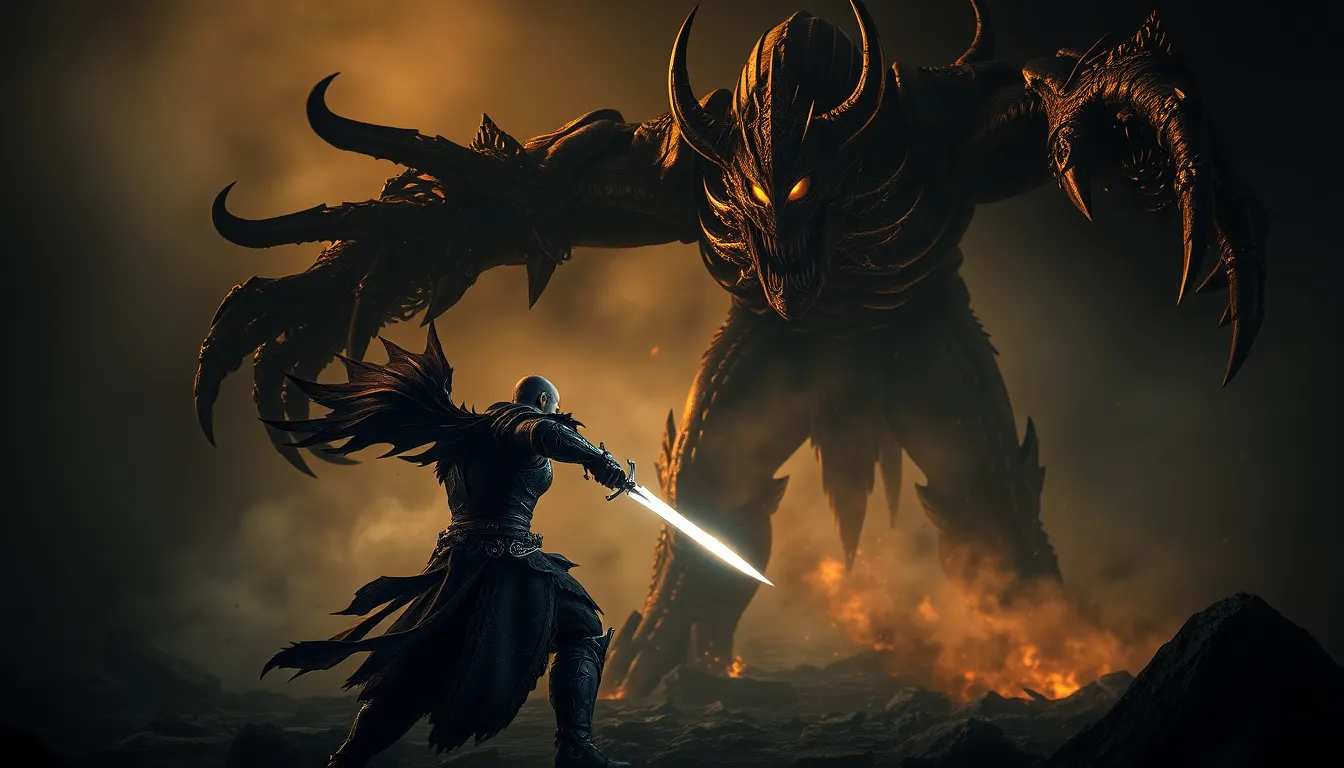Table of Contents
ToggleIn the realm of gaming, few series have earned a reputation as daunting as the Souls games. From the heart-pounding tension of Dark Souls to the relentless challenges of Bloodborne, these titles have become a rite of passage for gamers seeking to test their mettle. But let’s be honest: some are tougher than a two-dollar steak, while others might just make you question your life choices.
In this guide, he’ll dive into the world of Souls games ranked by difficulty, offering a lighthearted yet insightful look at what makes each game a unique challenge. Whether you’re a seasoned warrior or a newbie looking to dip your toes into the abyss, this ranking will help you navigate the treacherous waters of this beloved franchise. So grab your controller and prepare for a journey that’ll have you laughing, crying, and maybe even throwing your controller across the room.
Overview of Souls Games
Souls games cultivate a unique reputation for difficulty, creating iconic experiences in the gaming industry. Each entry in the franchise challenges players with intricate environments, formidable enemies, and deep lore. Players often face punishing trials, requiring persistence to master.
The series began with Demon’s Souls, which laid the groundwork with its dark ambiance and unforgiving gameplay. FromSoftware introduced innovative mechanics, such as the loss of souls upon death, which added tension and strategy. As gamers progress through its world, they encounter varied enemies that demand different combat approaches.
Dark Souls expanded on this concept, offering interconnected regions teeming with secrets. Its boss fights are legendary, featuring diverse tactics and powerful challenges. Players often describe the satisfaction derived from overcoming these trials, reinforcing the game’s reputation.
Dark Souls II provided a different experience, introducing new mechanics while maintaining the core essence. This entry featured adaptive difficulty, which some players found polarizing. The challenge remained high, yet player feedback highlighted some frustrations with its design.
Dark Souls III optimized elements from previous titles, combining fluid combat with breathtaking visuals. The game integrated familiar characters and rivalries, creating an emotional connection. Players found the difficulty balanced by rewarding exploration and mastery of combat.
Bloodborne, branching from the traditional formula, altered the pacing and combat mechanics. Speedy combat replaced defensive strategies, fostering a fast-paced experience. This shift attracted a new audience while still posing significant challenges.
Sekiro: Shadows Die Twice introduced a new level of complexity with its unique posture system. This game diverged fundamentally from its predecessors, enforcing a strong focus on timing and strategy. Players embraced its challenges, contributing to its acclaim.
Understanding each Souls game’s nuances aids players in selecting their ideal challenge. The varying difficulty levels and gameplay styles offer something for everyone, whether new to the franchise or seasoned veterans.
Factors Influencing Difficulty

Several factors contribute to the overall difficulty in Souls games. Understanding these elements assists players in navigating the challenges effectively.
Game Mechanics
Gameplay mechanics play a key role in difficulty levels. Each title introduces unique systems that affect player experience. For instance, the loss of souls upon death in Demon’s Souls sets a tone of risk. Dark Souls emphasizes stamina management and weapon types, which can alter combat strategy. In Bloodborne, healing requires a more aggressive playstyle, pushing players to balance risk and reward. Sekiro’s posture system heightens tension by focusing on precise timing. These mechanics not only challenge players but also encourage mastery and adaptation, impacting their journey through the game.
Enemy Design
Enemy design significantly impacts the perceived difficulty. Various enemies possess distinct attack patterns and behaviors, making encounters unpredictable. Boss fights often demand specific strategies, exploiting player weaknesses to create memorable challenges. For example, Dark Souls III introduces formidable bosses requiring optimal timing and positioning. Bloodborne’s faster enemies force quick reactions and adaptability. In contrast, Sekiro emphasizes one-on-one duels that test reflexes and skill. Intelligent enemy placement within environments also adds layers of complexity, fostering a sense of dread and urgency in exploration. Each design choice shapes player experiences, heightening the overall challenge throughout the series.
Souls Games Ranked by Difficulty
This section ranks the Souls games according to their level of difficulty, detailing the unique challenges each title presents. Players can use this guide to understand what lies ahead.
Demon’s Souls
Demon’s Souls sets the stage with a brutal difficulty that tests every player’s patience. Engaging with its dark world demands careful navigation through treacherous environments. Enemies possess aggressive behaviors, often leading to unexpected deaths. The mechanics surrounding soul loss upon death intensify the stakes, forcing players to tread carefully to recover lost rewards. Each boss encounter stresses the need for strategy and adaptation, highlighting the game’s demanding nature.
Dark Souls
Dark Souls raises the bar with its interconnected world design and punishing mechanics. Players encounter memorable bosses and treacherous paths that challenge their skills and resolve. Stamina management becomes crucial as melee combat relies on timing and precision. While the game offers a sense of accomplishment through exploration, every mistake can lead to significant setbacks. Despite its challenges, Dark Souls remains a beloved classic that rewards persistence and mastery.
Bloodborne
Bloodborne shifts the gameplay dynamic, introducing faster-paced combat that demands aggressive play. Players gain health back through offensive moves, creating a high-risk, high-reward scenario. Environments teem with hostile enemies and intricate designs, compelling players to remain vigilant. The game’s Gothic aesthetic and relentless pacing keep players on their toes, ensuring that no encounter feels safe. Bloodborne embodies an exhilarating challenge that appeals to those seeking speed and intensity in fighting.
Dark Souls II
Dark Souls II presents a unique difficulty curve with its adaptive challenge system. Variations in enemy resilience and AI behavior can surprise even seasoned players. Despite mixed reviews, its exploration of expansive areas and secrets remains compelling. Boss fights vary in difficulty, requiring varied strategies and preparations. The game’s approach to stamina and magic management adds additional layers to the overall experience, making it both frustrating and rewarding.
Dark Souls III
Dark Souls III optimizes gameplay through refined mechanics and challenging encounters. Combat shines with fluidity, and weapon variety aids players in tackling diverse challenges. Players witness emotional connections to NPCs that enhance the storytelling experience. The game retains the historic difficulty of its predecessors while introducing accessible gameplay elements. Boss battles demand precise timing and quick reflexes, ensuring that each victory feels hard-earned.
Sekiro: Shadows Die Twice
Sekiro: Shadows Die Twice redefines difficulty with its emphasis on timing and strategy. Players engage in combat with a unique posture system that rewards skillful parrying. The learning curve is steep, demanding that players master their timings and dodge capabilities. Every encounter presents distinct challenges, from stealthy approaches to intense boss fights. This game fosters a sense of triumph through its demanding mechanics, appealing to players who relish a formidable challenge.
Tips for Conquering Souls Games
Learning the mechanics is vital for success in Souls games. Players should take time to understand each title’s unique systems, such as the healing mechanics in Bloodborne or stamina management in Dark Souls. Mastering these systems ultimately leads to smoother gameplay.
Observing enemy behavior helps in developing successful strategies. Each enemy has distinct attack patterns that can be exploited. Learning when to dodge or counterattack can shift the battle in the player’s favor.
Utilizing the environment can provide tactical advantages during fights. Players can lure enemies into traps or use terrain to avoid damage. Recognizing the surroundings will lead to improved odds of survival.
Practicing timing is critical, especially in games like Sekiro: Shadows Die Twice. The posture system rewards precise attacks and defensive moves. Players need to hone their reflexes to unleash powerful counters.
Resource management plays an important role in maintaining progress. Souls and consumables can significantly affect encounters. Players should prioritize collecting souls and strategizing their use during tough sections.
Experimenting with different builds enhances the gaming experience. Customizing weapons and stats allows players to find their ideal playstyle. Trying various combinations keeps the gameplay fresh and adaptable.
Seeking help from the community can provide valuable insights. Many players share tips and strategies through forums and videos. Engaging with others leads to new discoveries and improved skills.
Staying patient is essential when tackling difficult sections. Frustration can lead to mistakes that hinder progress. Embracing a trial-and-error approach promotes resilience and mastery over time.
The journey through the Souls series is one marked by intense challenges and unforgettable experiences. Each game offers a unique blend of difficulty and rewarding gameplay that keeps players coming back for more. Whether it’s the punishing mechanics of Demon’s Souls or the strategic depth of Sekiro, each title demands skill and perseverance.
For gamers willing to embrace the struggle, the Souls games provide not just frustration but also immense satisfaction. By understanding the intricacies of each entry and applying strategic approaches, players can navigate these formidable worlds. The thrill of conquering a tough boss or mastering a tricky mechanic makes every victory feel earned and worthwhile.







